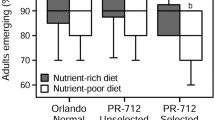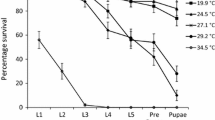Abstract
Comparisons between transgenic (T) and wild-type Metaseiulus occidentalis colonies (COS) were made under laboratory conditions as part of a risk assessment effort prior to proposed field releases. There were no differences between the transgenic T18 colony and the COS strain in the daily egg production, hatchability at three temperatures and four relative humidity (RH) conditions, diapause incidence, or proportion of female progeny produced. Metaseiulus occidentalis eggs do not hatch at 38°C under any RH tested, nor at 33.5°C under 100% RH, indicating that high temperature and extreme RH affect egg hatch negatively. At 28.5 and 33.5°C, fewer eggs hatched at 32.5% than at 75.5 and 93% RH. Metaseiulus occidentalis cannot survive on any plant tested without prey nor on a diet of pollen alone; adult female mites cannot prey or survive on a diet of eggs and larvae of two lepidopteran species, indicating that the suitability of food sources has not been altered in the transgenic strain. Two subcolonies, derived from two transgenic strains using single females, differed in the rate of egg hatch at 28.5°C under 32.5 and 100% RH, indicating that reduced genetic variation and/or random genetic drift in the two lines may have led to differences in some biological characters. Since we did not find any significant differences between the T18 and COS colonies in the traits tested, the T18 colony is not expected to exhibit any new biological attributes in a proposed short-term field release.
Similar content being viewed by others
References
Ehler L.E. 1991. Planned introductions in biological control. In Assessing ecological risks of biotechnology, L. R. Ginzburg (ed.), pp. 21–39. Butterworth-Heinemann, Boston.
Howarth F.G. 1991. Environmental impacts of classical biological control. Annu. Rev. Entomol. 36: 485–509.
Hoy M.A. 1982. Genetics and genetic improvement of the Phytoseiidae. In Recent advances in knowledge of the Phytoseiidae, M. A. Hoy (ed.), pp. 72–89. University of California Div. Agric. Nat. Res. Publ. No. 3284, Berkeley.
Hoy M.A. 1984. Genetic improvement of a biological control agent: multiple pesticide resistance and non-diapause in Metaseiulus occidentalis (Nesbitt). In Acarology VI, Vol. II, Proceedings of the VI International Congress of Acarology, D. A. Griffiths and C. E. Bowman (eds.), pp. 673–679. Ellis Horwood, Chichester.
Hoy M.A. 1985. Recent advances in genetics and genetic improvement of the Phytoseiidae. Annu. Rev. Entomol. 30: 345–370.
Hoy M.A. 1992. Criteria for release of genetically-improved phytoseiids: an examination of the risks associated with release of biological control agents. Exp. Appl. Acarol. 14: 393–416.
Hoy M.A. 1995. Impact of risk analyses on pest-management programs employing transgenic arthropods. Parastiol. Today 11: 229–232.
Hoy M.A. and Flaherty D.L. 1970. Photoperiodic induction of diapause in a predaceous mite, Metaseiulus occidentalis. Ann. Entomol. Soc. Am. 63: 960–963.
Hoying S.A. and Croft B.A. 1977. Comparisons between populations of Typhlodromus longipilus Nesbitt and T. occidentalis Nesbitt: Taxonomy, distribution, and hybridization. Ann. Entomol. Soc. Am. 70: 150–159.
McDermott, G.J. and Hoy, M.A. In press. Persistence and containment of Metaseiulus occidentalis (Acari: Phytoseiidae) in Florida: risk assessment for possible releases of transgenic strains. Florida Entomol.
Muma M.H. and Denmark H.A. 1970. Phytoseiidae of Florida. Arthropods of Florida and neighboring land areas. Vol. 6. Fla. Dept. of Agric. Consumer Serv., Gainesville.
Northcraft P.D. and Watson T.F. 1988. Developmental biology of Typhlodromus occidentalis (Nesbitt) under three temperature regimes. Southwestern Entomol. 13: 69–74.
Presnail J.K. and Hoy M.A. 1992. Stable genetic transformation of a beneficial arthropod, Metaseiulus occidentalis (Acari: Phytoseiidae) by a microinjection technique. Proc. Natl Acad. Sci. USA 89: 7732–7736
Presnail J.K., Hoy M.A. and Jeyaprakash A. (1996). Developing transgenic phytoseiids for biological control programs. In Acarology IX: symposia. Vol. 2, G.R. Needham, R. Mitchell, D.J. Horn and W.C. Welbourn (eds.). Ohio Biological Survey, Columbus, Ohio.
Sharples F.E. 1991. Ecological aspects of hazard identification for environmental uses of genetically engineered organisms. In Risk assessment in genetic engineering. Environmental release of organisms, M. Levin and H. Strauss (eds.), pp. 18–31. McGraw-Hill Press, New York.
Swirski E. and Dorzia N. 1969. Laboratory studies on the feeding, development and fecundity of the predaceous mite Typhlodromus occidentalis Nesbitt (Acarina: Phytoseiidae) on various kinds of food substances. Isr. J. Agricult. Res. 19: 143–145.
Tanigoshi L.K., Hoyt S.C., Browne R.W. and Logan J.A. 1975. Influence of temperature on population increase of Metaseiulus occidentalis (Acarina: Phytoseiidae). Ann. Entomol. Soc. Am. 68: 979–985.
USDA-APHIS, BBEP 1996. The regulation of transgenic arthropods. World-wide web http:// www.aphis.usda.gov/bbep/bp/arthropod/.
Winston P.W. and Bates D.H. 1960. Saturated solutions for the control of humidity in biological research. Ecology 41: 232–237.
Author information
Authors and Affiliations
Rights and permissions
About this article
Cite this article
Li, J., Hoy, M.A. Adaptability and efficacy of transgenic and wild-type Metaseiulus occidentalis (Acari: Phytoseiidae) compared as part of a risk assessment. Exp Appl Acarol 20, 563–573 (1996). https://doi.org/10.1007/BF00052807
Received:
Accepted:
Issue Date:
DOI: https://doi.org/10.1007/BF00052807




